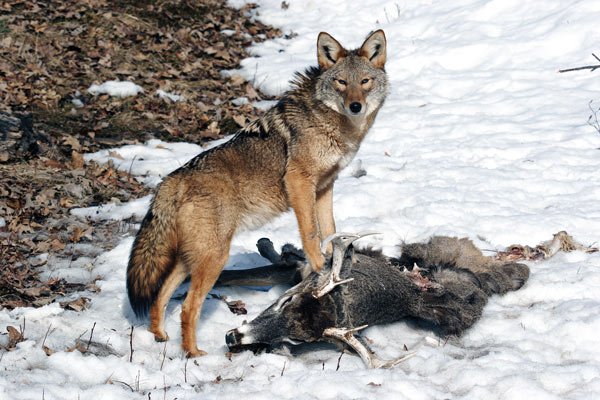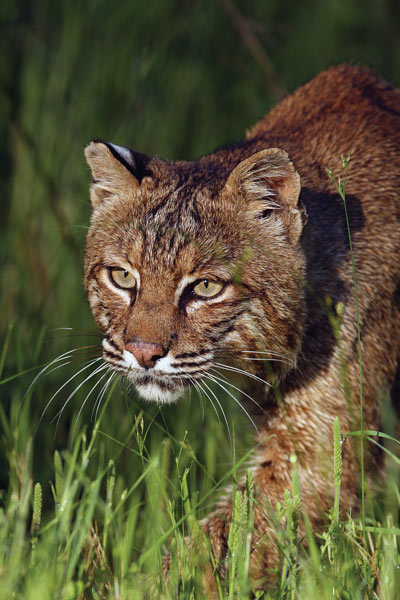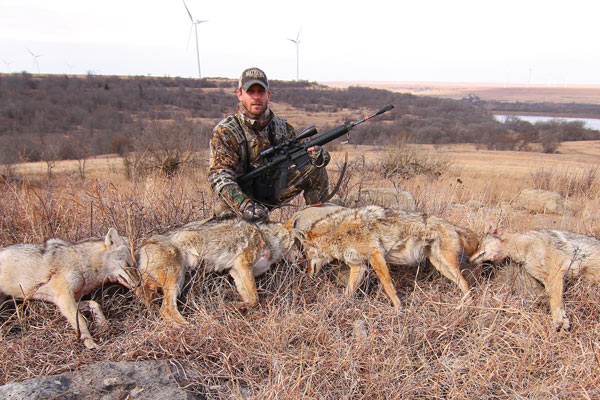February 10, 2015
By Patrick Hogan
 Sunken into the dry, dusty brush and grass filling the gaps between rocky outcrops, I surveyed the draw — almost a canyon — through my rifle scope. "Ready," I whispered to my hunting partner, satisfied with my line of sight in several directions.
Sunken into the dry, dusty brush and grass filling the gaps between rocky outcrops, I surveyed the draw — almost a canyon — through my rifle scope. "Ready," I whispered to my hunting partner, satisfied with my line of sight in several directions.
Eagle Head Outfitters owner and southeast Kansas native Josh Hedges hit a button on his electronic predator call and twisted the volume knob. The painful wailing of a whitetail fawn in distress flooded the silence, echoing against the opposite side of the draw and racing up and down its length. And then, silence.
Several seconds later Josh again worked the controls, and this time a mix of coyote yips and barks and howls resonated across the landscape.
As if on cue, a flash of movement in the draw broke the inertia. I watched as a dozen whitetails busted out of the thick cover heading somewhere, anywhere, but there. I scanned up and down the draw, searching for the cause of their distress, but found none. I concluded the very sound of a coyote killing a fawn had sparked such an urgent need to flee in these whitetails that they would expose themselves in full daylight.
Advertisement
As the doe group disappeared into another canyon, it was difficult to ignore the thought that this was an all-too-familiar occurrence for whitetails in Kansas. Or, for that matter, in the eastern U.S., where coyotes — once a rarity — have taken a foothold on the land and quite literally a bite out of the whitetail herd.
And they're not alone. As coyotes flood eastward and northward, filling virtually every nook and cranny of viable habitat between Florida and eastern Canada, the gray wolf is stalking the North Woods and northern Rockies. Black bear populations are swelling, and sighting the elusive bobcat is hardly a rare occurrence. Even mountain lions are showing up in new places. And all of this is happening as we humans continue to take millions of deer every year.
Meanwhile, whitetails are facing a host of other issues. Habitat loss, changes in human land-use patterns, disease, hunter harvest and an assortment of other challenges all represent some level of threat. A suite of whitetail predators the likes of which hasn't been encountered in a century or more is only adding to the difficulty in maintaining high deer numbers.
Advertisement
As evidenced by the white flags waving over the Kansas landscape that spring evening, it's become a scary world for the whitetail. But how serious is the threat of predation on the long-term viability of the herd? In light of other challenges, are predators the final straw that will push deer over the tipping point? And what, if anything, can we as hunters and conservationists do about it?
The Threat is Real
Without question, the whitetail now exists in an ecosystem characterized by far more predators — and more types of predators — than was the case 40, 20 or even 10 years ago.
"Here's the thing with predation: Throughout most of the eastern United States, we have historically managed deer herds in the absence of predation," says Karl V. Miller, professor of wildlife ecology and management at the University of Georgia. "We just figured that most of the predation occurred at the hands of sportsmen. That has changed. We have a predator context in the eastern United States that we historically have not had, and it needs to be taken into account in managing deer."
Miller is among those spearheading a new study that will include a close look at land-use patterns of coyotes in the Southeast. He's spent much of his career studying whitetails and the factors that influence them. He notes the coyote's colonization of the eastern U.S. is a fairly new phenomenon.
In an article published in the Journal of Wildlife Management in 2009, Miller, along with coauthors John Kilgo, H. Scott Ray and Charles Ruth, discussed the expansion of coyotes in no uncertain terms.
"During the last half of the 20th century, the range of the coyote expanded dramatically," Miller and his colleagues wrote. "Coyotes now occupy most of North and Central America. Eastward of the historic western range, coyotes now occur throughout eastern North America from New Brunswick, Canada, to Florida, USA."
Although some evidence exists to suggest this rapid expansion occurred in part because of the extermination of other predators, the coyote is hardly the only carnivorous threat to whitetails.
"The point to be made here is that we're not just talking about one predator," says Dr. James C. Kroll, director of the Institute for White-tailed Deer Management & Research at Stephen F. Austin State University. "It's an entire suite of predators."
Kroll is not alone in his assessment. Researchers in the North Woods of Wisconsin, Minnesota and Michigan have noted increased predation of whitetails by wolves. Bobcats are impacting fawn survival in several regions. And mountain lions are efficient ambush predators of adult deer — bucks in particular. The black bear has proven to be a significant killer of fawns throughout its range.
"In some areas of the United States, bears can have more of an impact (on whitetails) than coyotes or wolves," says Kyle Ravana, who heads up Maine's deer management program. "In other areas, it could be coyotes or bobcats that are having the biggest impact. It kind of depends on where you are.
"When you're in a state like Maine, that has a full suite of predators — coyotes and bears and bobcats and wolves — you can't point your finger at any one predator. It could be all of them combined, including hunters."
Point of Impact
While there appears to be no question predator populations are rising across the whitetail's range, there is debate as to whether or not those predators — particularly the coyote — are having a tangible impact on mortality, or to what extent predators as a group they are driving down deer numbers.
 John Kilgo, a research wildlife biologist at the U.S. Forest Service Southern Research Station in New Allenton, South Carolina, is convinced coyote predation has had a drastic impact on fawn survival in the Southeast — particularly where regulations have historically allowed for hunter harvest to keep deer populations low.
John Kilgo, a research wildlife biologist at the U.S. Forest Service Southern Research Station in New Allenton, South Carolina, is convinced coyote predation has had a drastic impact on fawn survival in the Southeast — particularly where regulations have historically allowed for hunter harvest to keep deer populations low.
"South Carolina, North Carolina, Georgia and Alabama all have very high levels of predation — surprisingly high levels," he says. "Predation levels are significant enough to push population trends down, given the level of doe harvest we've become accustomed to."
Kilgo's research suggests that in parts of the Southeast, coyote predation accounts for as much as 60 percent of fawn mortality. In specific areas of the region, the impact appears to be even greater. Kilgo worked with South Carolina Department of Natural Resources Deer Project Supervisor Charles Ruth on an extensive study of the impact of coyote predation on fawns at the state's Savannah River Site. Over the first three years of the project, the researchers found approximately 80 percent of fawn mortality there was due to coyotes.
"If these findings even moderately represent a statewide situation, this 'new mortality factor' is clearly involved in the reduction of deer numbers," Ruth says. "This is especially true when combined with extremely liberal deer harvests that have been the norm in South Carolina."
Even as that study's data seem to indicate predation is having a tangible impact on deer in the Southeast, biologists and state agency officials in other parts of the continent express skepticism predators are a major factor in population dynamics.
"It's my observation that the greatest factor affecting the demographics of white-tailed deer herds is hunter harvest," says Duane Diefenbach, an adjunct professor of wildlife ecology at Pennsylvania State University and leader of the Pennsylvania Cooperative Fish and Wildlife Research Unit based at PSU. "That's the major issue determining whether herds go up or down. This idea that coyote predation has increased and somehow it's causing declines in the deer population isn't borne out in the data."
This caution about labeling predation as a major driver of whitetail populations extends beyond Pennsylvania. In Wyoming, wildlife biologist Grant Frost says predators take a back seat to other factors when it comes to managing whitetail numbers.
"Most of our concerns center on disease and drought or habitat issues," Frost says. "As long as we can work with the private land managers, predators are not that big of a concern in Wyoming. They're certainly a factor, but not the biggest factor in the numbers of whitetails we have here."
And in Maine, Ravana says he lacks the data needed to determine if predators are having a significant impact on deer mortality.
"We really don't have a good handle on the relationship between predator and prey in Maine," he notes. "And partly because of that, we're getting ready to begin a survival study in which we'll collar 40 whitetails. One of things we'll try to measure is cause-specific mortality. Are the coyotes really having the impact we think they're having?"
With so much apparent dissension over the impact predators — coyotes in particular — have on whitetail herds in different parts of North America, the question remains: Is predation truly a force to be reckoned with across the range, or is it largely a regional phenomenon?
"There is no question coyotes have had an impact (on whitetail populations) in the southeastern United States," says Miller, "but likely more so in some regions than in others. If you look at the impact of coyotes on whitetails — and fawns in particular — their influence seems to be more profound in the Southern deer herd than in the Northern deer herd.
"The coyote impact is highly variable," he adds. "The result of what you do about it is not 'one size fits all.'"
Moving Forward
So what can be done to mitigate the impact of predation in areas where deer numbers are clearly declining at the hands — or claws — of predators? The answers are varied and complex, but nearly all theories contain one common element: influencing the whitetail population by altering hunter harvest of adult does.
"The bottom line is, if you want more deer, reduce the doe harvest," Diefenbach says. "There's almost no situation in eastern North America where, if you decrease the doe harvest, deer populations won't increase, even in spite of coyote predation."
Diefenbach's premise goes hand in hand with the idea that, while hunter harvest might be able to manage bear populations (or perhaps, even wolf populations), there is little hunters can do to control a species as prolific, adaptable and resilient as the coyote.
Kilgo's research in the Southeast appears to support the claim coyote control is a lofty goal — and he questions it has a tangible impact on fawn mortality. As part of a recent study, the research team employed contract trappers on three separate South Carolina tracts over three years. Their task was clear: remove as many coyotes as possible. Over the course of the study, the trappers removed hundreds of coyotes from the tracts. Meanwhile, the researchers measured the impact on fawn survival. The increase was modest at best.
"The first year, (fawn survival) did double," Kilgo says, "but it doubled from a very low number. The second year it did nothing at all. The conclusion being, we went to a tremendous amount of time, effort and expense to remove a lot of coyotes and got a very modest return."
Kilgo points out that hunters in South Carolina already kill an average of 1.5 coyotes per square mile on an annual basis. Still, their efforts have a negligible impact on the overall number of predators.
"That's 30,000 coyotes removed, on average, and it appears to be a drop in the bucket," he says. "It's tempting to say, 'Don't waste your lead."
Unfortunately, Kilgo says, the same can be said for improving fawn cover. In a study comparing fawn mortality rates in areas with good fawn cover to those in areas where fawn cover was poor, he could find no impact.
"Cover did not seem to make a difference," Kilgo says. "I would hesitate to tell anybody not to improve their cover, but we didn't see it held much water with regard to reducing fawn mortality due to coyotes."
 Despite the resiliency of coyotes, some researchers are reluctant to put all of their efforts into improving deer numbers in the hands of state agencies that dictate doe harvest.
Despite the resiliency of coyotes, some researchers are reluctant to put all of their efforts into improving deer numbers in the hands of state agencies that dictate doe harvest.
"The real take-home message is that we have not been managing deer," says Kroll. "It is no longer that simple. It's complex. State agencies look at deer management as setting the deer season and bag limit, and it's more complicated than that.
"We haven't done a good-enough job of putting educational matter out there about controlling or managing predators. I am not saying I am for the extermination of these predators, but true deer ecosystem management means we manage all of the elements of the deer ecosystem. That means we manage wolves and bobcats and coyotes and bears as game animals."
Kroll also points to some of the pitfalls of reducing deer harvest numbers, emphasizing that a decrease in allowable permits could result in a decline in hunter numbers as well.
"When the prey population falls to a certain level, the predator tends to shift to an alternate species," he says. "As time goes on, we're going to see fewer hunters and more golfers."
In all cases, it appears the predators are here to stay. If we hunters and land managers wish to protect the whitetail as a resource for future generations, we must be involved in the process of conservation and problem-solving required to overcome not only the challenge of increased predation but also other issues facing the whitetail population.
"Reducing doe harvests in areas where you think you have declining recruitment may be part of the answer, but it can't be the only answer," says Miller. "Part of the rest of the answer is understanding the predators that we have out there . . . and the landowner and hunter need to become more involved."

